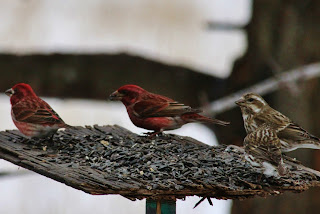winter surprises
WINGIN’
IT
By
Kate Crowley
We are as surprised as
I imagine some of the returning birds are to discover this much snow on the
ground in mid-April. When we left for the south for three weeks on March 23 I
skied our trails ‘one last time’, or so I told myself. And now it looks like I may be able to ski
for another week, based on the extended forecast, although the snow is very
sticky.
We discovered dark eyed
juncos, the so called ‘snowbirds’ because they leave every autumn before the snow
falls and return when its gone (or nearly so), and purple finch
which we did not see in all the previous five months at our feeders. That was rather unusual, because they typically are winter visitors. I’m not sure where they went this winter, but we are happy to see them back in our yard.
which we did not see in all the previous five months at our feeders. That was rather unusual, because they typically are winter visitors. I’m not sure where they went this winter, but we are happy to see them back in our yard.
While we were gone, we
believe the raccoons came out of their winter dens because one of our best feeders
that our neighbor Dick kept filled for us was thoroughly dismantled. A bear would have taken it away and pried it
open, but raccoons with their nimble digits can do more fine motor activity
removing smaller parts until the feeder comes apart. This one had a plastic tube set inside a
metal wire cage. Now we need to find the
parts to put it back together because it was one of the best feeders we had
that the squirrels couldn’t empty.
But back to our new
visitors: I’m wondering if the purple
finches weren’t blown in with the coming (next) snowstorm. There is a large (12-15) flock of males and
females. They are called finches, but
they belong to the Family called Emberizidae, which includes grosbeaks,
sparrows and bunting. The female purple finches are the typical sparrow brown
with streaks and stripes on their head, chest and wings. The males however, shine
with pretty rouge covering their head and chest. Purple it is not. You have to wonder about the common names
some birds have been given (although the explanation is that they are the color
of the robes the Romans wore they called it Purple). They have the heavier, conical beaks designed
for opening the shells of tough nuts and seeds. Our return has meant that the
sunflower seeds are constantly replenished during the day by Mike, especially
on days like this when the wind is gusting through the branches and the snow is
coming down.
The little grey and
white juncos have to be wondering how they got the timing so wrong on their
return. Normally, they would be pecking
about on the ground for old seeds in the newly exposed grass, but not this
year. I wonder whether some birds
actually turn around and fly south to better conditions. We noticed on our drive home yesterday, that
the heavy snow cover really didn’t start until Sandstone so pickings are probably
better down south.
The difference between
last spring and this one are so dramatic.
Talk about extremes. This is one reason it is so hard to accept these
last, late snowstorms. Memories of the
unusually early and warm spring of 2012 are still fresh in many minds.
I know that lots of
waterfowl and even some sand hill cranes have been seen up in this region in
the past two weeks and luckily the rivers are mostly open, since the lakes are
still sealed tight. Our little ponds are
showing openings though, so we should take these signs as reminders that the
sun is continuing its march northward and it will win this battle with winter -
eventually.





Comments
Post a Comment